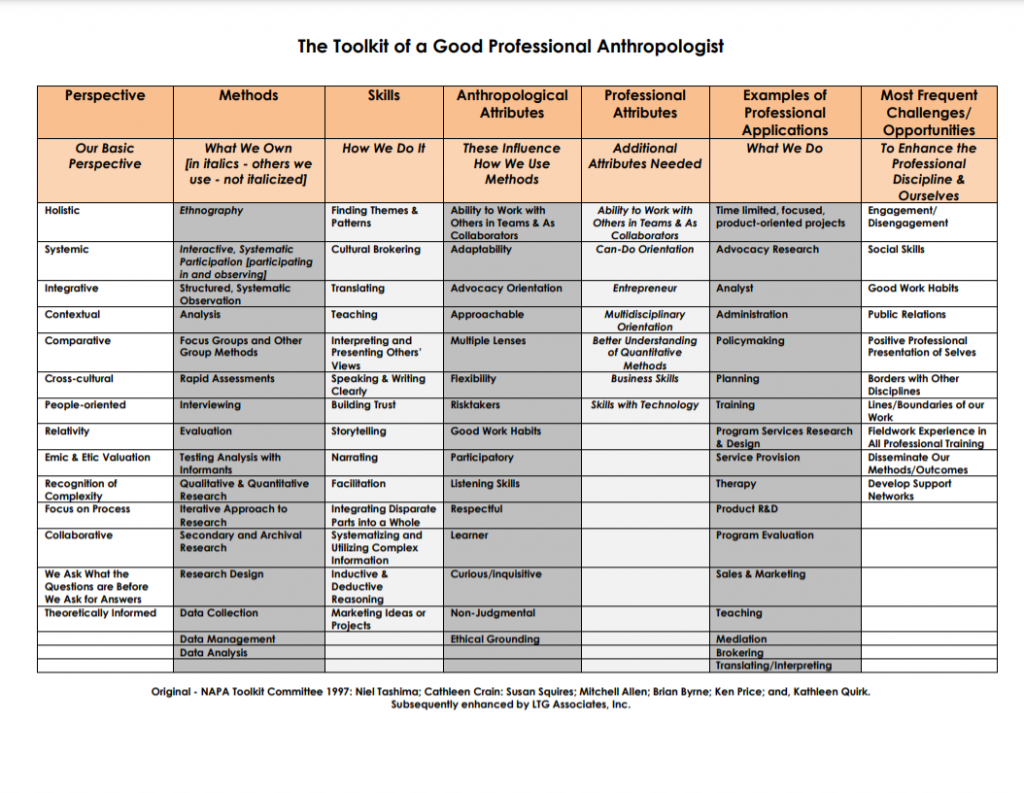National Association for the Practice of Anthropology
The Toolkit of a Good Professional Anthropologist

Instructions for use of the Toolkit: read, discuss, debate, share, add, repeat!
Background. The NAPA ToolKit of Professional Anthropology was developed as a result of an important discovery made by the NAPA Strategic Planning Group over two decades ago. While professional development was considered a priority by many anthropologists, the content of what needed to be developed was poorly defined. From that group sprang a committee that sought to begin the process of defining the toolkit of a good professional anthropologist. At the time it was developed, the Toolkit represented the shape of anthropology in current contexts. The Toolkit was largely focused to the use of cultural anthropology and could be developed in future iterations to reflect the whole of the discipline.
Professional anthropologists are defined by the fact that they earn their living in the general work arena rather than through teaching and related research. 1 Secondly, the defining of a toolkit for professional anthropologists is an exploration, not an end point. It was recognized early on by the Committee that what anthropologists do is complex and that any exercise in defining that would require ongoing input from a variety of sources. In fact, the Toolkit underwent serial changes as it was reviewed by various groups of anthropologists, and after the Committee completed its work in the late 1990’s several of its members have updated it further. Finally, the Toolkit was intended to be a think piece for the Committee and gained a life of its own as people have reviewed and commented on it, and it has sparked thinking about the task of defining what we do and the nature of our work. The ultimate goal of the Committee was to assist anthropologists in communicating clearly among ourselves and with others about who we are, what we do, how we do it, and the essential philosophical and theoretical ground rules of our discipline as practiced by professional anthropologists.
Why the Toolkit is useful. First, it has sparked animated and sometimes heated discussions among anthropologists. We have a history as a discipline of defining our discipline largely by indirection, a development perhaps based in our roots as an apprentice-type discipline. The direct defining of ourselves is something that has often been left to outside observers who frequently use the crudest of measures of what we do. Therefore, the very discussion appears to be useful in surfacing categories and creating working definitions. Professional anthropologists, and those who would teach aspiring professional anthropologists, are constantly challenged to define skills and tools. Therefore, well thought out, carefully constructed information that will speed their work is essential.
Who has had reviewed the Toolkit? The graphic has been widely circulated and comments has been actively solicited. The graphic has been circulated through NAPA and SfAA, and through a variety of Local Practitioner Organizations. It was published on Anthap and is in circulation in both the U.S. and Canada. It has been reported that it has been used as a teaching aid.
The Committee been made up of NAPA members and was originally constituted in California for the convenience of being able to meet easily and for extended periods. Original Committee members were: Niel Tashima; Cathleen Crain; Susan Squires; Mitchell Allen; Brian Byrne; Ken Price; and Kathleen Quirk.
- We now talk about Professional, Practicing, and Applied (PPA) anthropologists to /represent the continuum of anthropologists whose work is focused on the application of anthropological tools to real world issues. Professionals are those whose work and professional identity is defined by being an anthropologist. Practicing anthropologists are those whose work identification may not be as an anthropologist but who bring those skills to their professional endeavors. Applied anthropologists are those who are academically based but whose work is generally focused on research that is designed to directly affect conditions in the world.
